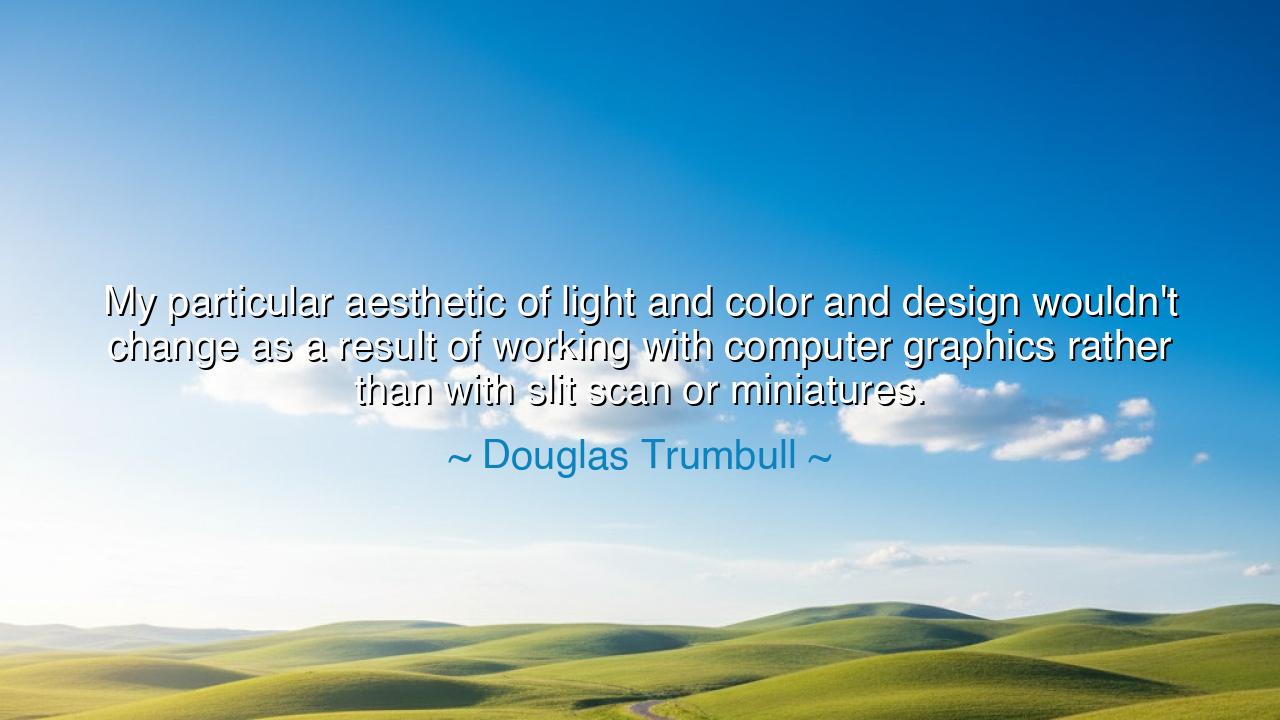
My particular aesthetic of light and color and design wouldn't
My particular aesthetic of light and color and design wouldn't change as a result of working with computer graphics rather than with slit scan or miniatures.






The words of Douglas Trumbull — “My particular aesthetic of light and color and design wouldn’t change as a result of working with computer graphics rather than with slit scan or miniatures.” — are the words of an artist who understood that tools do not define vision; vision defines tools. Trumbull, the legendary visual effects pioneer behind films such as 2001: A Space Odyssey, Close Encounters of the Third Kind, and Blade Runner, speaks here not merely of technology, but of artistic constancy, of the eternal essence of creativity that survives the passage of eras. His declaration is both humble and defiant — humble in its devotion to craft, defiant in its refusal to let machinery dictate meaning. To him, whether light was bent through glass or rendered by code, the soul of the image remained untouched, for art was born not from the hand that shaped it, but from the mind that conceived it.
To understand his words, one must first remember the world from which they arose. Trumbull was a craftsman of the old world of cinema — an age of smoke and mirrors, of lenses and paint and patience. In 2001: A Space Odyssey, his work with the slit-scan technique — an intricate dance of lights, mirrors, and long-exposure photography — created the iconic “Stargate” sequence, a journey through infinity that seemed not of science but of the divine. Every frame was touched by human hands, guided by intuition and wonder. And yet, as the years passed, the film world turned toward computer graphics, replacing the tangible with the digital. Many artists were lost in this transformation, mistaking new tools for new truth. But Trumbull saw beyond it — he knew that whether he shaped galaxies with machines or with his own hands, the principles of beauty were eternal: balance, rhythm, harmony, and the dance of light upon darkness.
His quote, then, is not a mere defense of his style, but a philosophy of creation. The artist, he reminds us, must never become a servant to his instruments. Technology is the brush, not the painter. It is the wind, not the sailor. What matters is the vision that directs it — the unchanging inner compass that gives meaning to form. For light and color are not inventions of man; they are the language of the universe, ancient and sacred. Trumbull’s commitment to his “aesthetic of light and color and design” is the commitment of all great artists: to honor the eternal while navigating the new, to preserve soul amidst machinery.
The ancients, too, understood this truth. When the sculptor Phidias carved the statues of the gods, his tools were of bronze and stone, but his vision was divine — he sought proportion, radiance, and life. Centuries later, Leonardo da Vinci, sketching with ink and imagination, wrote that “the painter’s mind must see the light before his eyes ever do.” Both would have recognized Trumbull as a kindred spirit — a man who sought not the mechanism of art, but its mystery. And though Trumbull’s materials were wires and projectors, his heart was that of a classical artist, striving to capture the numinous glow that lies between sight and spirit.
Indeed, his life’s work was a bridge between eras — between the tactile world of miniatures and the virtual realm of pixels. He understood that progress in art does not come from abandoning the past, but from carrying its flame forward into new domains. This is the wisdom that modern creators so often forget: that technology, for all its power, cannot replicate the intuition of the human hand, nor the emotion of the human eye. When Trumbull says his aesthetic would not change, he is affirming that artistic identity is greater than any medium. To the true artist, whether the canvas is paper or digital, the core remains — the pursuit of beauty through discipline, the search for transcendence through form.
Consider the modern world, overflowing with tools that promise instant mastery — software that paints, algorithms that compose music, machines that sculpt from code. Yet what Trumbull teaches is that the essence of art is not in the ease of creation, but in the intention behind it. The hand guided by meaning will always surpass the machine guided by calculation. His words are a call to all artists, programmers, and dreamers: to remember that technology amplifies talent but cannot replace soul. Light and color, in any age, still answer to the same eternal laws, and only those who understand their harmony can wield them rightly.
So, my child, let this be the lesson drawn from Douglas Trumbull’s wisdom: Honor your vision above your tools. Learn the craft, but do not worship the instrument. Whether you shape your world with chisel or computer, with paintbrush or processor, let your heart remain your truest medium. For tools will change with every generation, but the artist’s duty will not — to bring light from shadow, meaning from form, and wonder from the mundane. The medium may evolve, but the mission endures. And as Trumbull knew, it is not the machinery that defines the masterpiece, but the unchanging flame within the maker that turns even the cold precision of technology into an act of eternal beauty.






AAdministratorAdministrator
Welcome, honored guests. Please leave a comment, we will respond soon